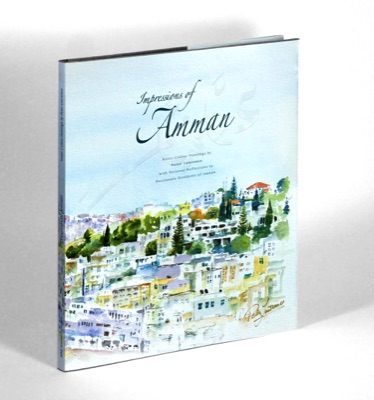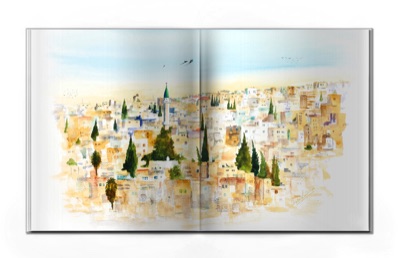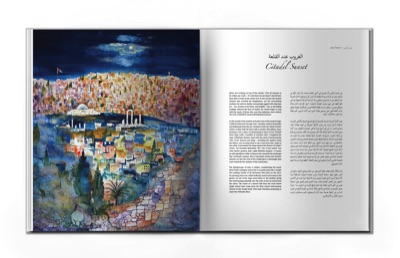


The Jordan Times Tuesday July 31st
Impressions of Amman, Peter Lawrence
Jabal Amman Publishers 2012 - Printed in Jordan by the National Press, Pp. 120
This coffee-table book has the power to teach history, bring back memories, elicit a wealth of feelings, recreate lives, reconstruct neighbourhoods, offer unexpectedly good literature, and aesthetically please the eye with images at once dear and iconic, tender and surprising.
Boasting a “foreword from HRH Princess Muna Al Hussein, watercolour paintings of Amman by Peter Lawrence complemented by written impressions of the city by some of its prominent residents”, the book lives up to its promise. It gives the reader more than a few random thoughts and some colourful images; it exudes love, wisdom and nostalgia, presents instructive bits of history and enchants with the renditions of this talented water and environmental engineer whose “long career has involved extensive travel throughout the Middle East and periods of residence in Saudi Arabia, Egypt, the UAE and Jordan” where he started living in 2010.
The book, “dedicated to the people of Amman”, is the second about Jordan (the first was “Colours of Jordan, 2011); these two were preceded by “Al Khaleej and beyond — reflections of two artists” (2007), produced while living in Dubai.
“Impressions of Amman” captivates both with its artworks of indisputable talent and with the words from the heart of the contributors, locals and expatriates residing in the capital, who recount history, personal memories, enlighten, impress and are united by a common thread: love for and belonging to this 10-millennia-old city that witnessed both glory and neglect but that has been consistently growing, accommodating wave after wave of newcomers and, in the process, becoming a sprawling metropolis.
“Numerically the city has exploded… and yet my neighbourhood keeps the daily tempo of pleasures, prayer and caring for each other that has given Amman its character,” says Suhail Bisharat, one of the contributors to the text of the book.
The book offers glimpses at the history of the city — like Jane Taylor's most poetic expounding on the city's long history or Barbara Porter's more “scientific” presentation — or poignant, personal feelings for it, its neighbourhoods and inhabitants, like those of Rami Daher, Samar Dudin or Nadia Dajani.
Then, there are thoughts about modern-day Amman, censuring yet appreciative, like Chris Johnson's, talk about “a new urban culture”, like Ahmad Humeid's, and reminiscing about the pain of refugees who at all times found a haven in Amman, a city towards which Hazem Malhas feels “respect, humility and a huge sense of pride”.
There is also the acknowledgement that Amman, through all its growth and history, never forgot “the principles on which it was founded; it has not forgotten its first social contract. It endures a lot but does not moan or complain because its basic law is that it should be a refuge and a homeland…,” as eloquently put by Ma'moon Altalhoni.
Reading is captivating. Thoughts of coexistence, of happy, homely, normal life happenings in a city that strives to cope with rapid growth permeate throughout. Most writers hark back to the times when neighbours were family, when life was simpler, ideals lofty, pioneers of both genders and in many fields abounded, intellectuals and artists found place, and willing ears, to express their ideas and all felt they belonged to Amman and the country, proud inhabitants who now find it necessary to preserve and contribute to their beloved city.
Throughout, and delightfully complementing the writing, Lawrence's water colours bring to life city and nature, capture in intricate detail beauty and activities, document an Amman that could soon change.
His renditions of historic places and landmark buildings — the Citadel, the Roman theatre, an Umayyad building, King Hussein and Abu Darwish mosques — of old streets and new skylines, of pigeons, urns, columns and capitals, of old walls and trees, of the ubiquitous stairways and sloping streets, of flowers, trees, cats looking for food in a trash bin, sheep roaming the city streets, famous houses and people going about their daily lives recreate a microcosm, bring to life the city in vibrant colours and heart-warming instances.
The text is written in both Arabic and English, enabling both locals and foreigners access to its reflections.
The book is a labour of love from Lawrence, whose works were exhibited in solo and group exhibitions in Amman and abroad. They adorn homes and offices in Jordan, Europe and the UAE.
The book is available at Jacaranda Images, The Good Book Shop, Readers and Aramex outlets.